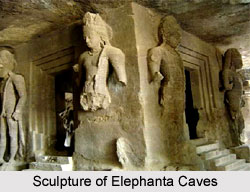 Rashtrakuta sculpture is reflected in the splendid rock-cut cave temples at Ellora and Elephanta in Maharashtra. The main structures built during the rule of the Rashtrakutas were the rock cut caves. These caves belonged to varied religious faiths: Buddhist, Jain and Hindu (Shaiva and Vaishanava). Contribution of the Rashtrakuta dynasty which ruled in Karnataka and many other parts of South and central India, in sculpture is immense. In the Elephanta caves a series of elephants carved on the lower pedastal create an illusion that they are carrying the Kailas. Several episodes taken from mythology related to Shiva, Vishnu and other Gods depict incidents from epics like Ramayana, Mahabharata and Bhagavata are carved on the walls. Dashavatara temple, ravan-ka-Khai temple, dhumar lena cave and Rameshvara temple are well known among the Hindu temples. Indrasabha, Jagannatha sabha and cota kailas are known for their sculptures. Cave 32 is known for the Yakshi sculpture and the paintings on the ceiling. These caves are famous for the icons of the teerthankaras, yakshas and yakshis.
Rashtrakuta sculpture is reflected in the splendid rock-cut cave temples at Ellora and Elephanta in Maharashtra. The main structures built during the rule of the Rashtrakutas were the rock cut caves. These caves belonged to varied religious faiths: Buddhist, Jain and Hindu (Shaiva and Vaishanava). Contribution of the Rashtrakuta dynasty which ruled in Karnataka and many other parts of South and central India, in sculpture is immense. In the Elephanta caves a series of elephants carved on the lower pedastal create an illusion that they are carrying the Kailas. Several episodes taken from mythology related to Shiva, Vishnu and other Gods depict incidents from epics like Ramayana, Mahabharata and Bhagavata are carved on the walls. Dashavatara temple, ravan-ka-Khai temple, dhumar lena cave and Rameshvara temple are well known among the Hindu temples. Indrasabha, Jagannatha sabha and cota kailas are known for their sculptures. Cave 32 is known for the Yakshi sculpture and the paintings on the ceiling. These caves are famous for the icons of the teerthankaras, yakshas and yakshis.
The Elephanta caves are known for the huge three-faced icon of Mahadeva. The faces represent sadyojata, agora and tatpurusa which are the three forms of Shiva. Sculptures of sadashiva and nataraja are well sculpted reliefs. The rock-cut temple is similar to a huge sculpture. kalyanasundara, gangadhara, ravananugrahamurty and yogishvara are sculpted on the West and East sides of the Northern entrance.
Some more sculptures built during the regime of the Rashtrakuta kings are found in the districts of Gulbarga, Bijapur, Dharwad and Raichur. A solitary Jaina basadi stands in a decaying condition in Malkhed the capital of the dynasty. The parameshvara temple at konnur and brahmeshvara temple at savadi have some sculpture. The walls of many of these temples have carved sculptures depicting incidents from mythology and epics. The icons have undergone subtle changes in body contours and ornamentation though they follow the models given by the Chalukyas of Badami.
One of the main features of Rashtrakuta sculptures is the variety that these present to the beholder. The cave temples were etched out of single rocks and then given a proper shape. Besides the Buddhist themes there are Hindu motifs as well. Their sculpture bear testimony to India`s religious unity.



